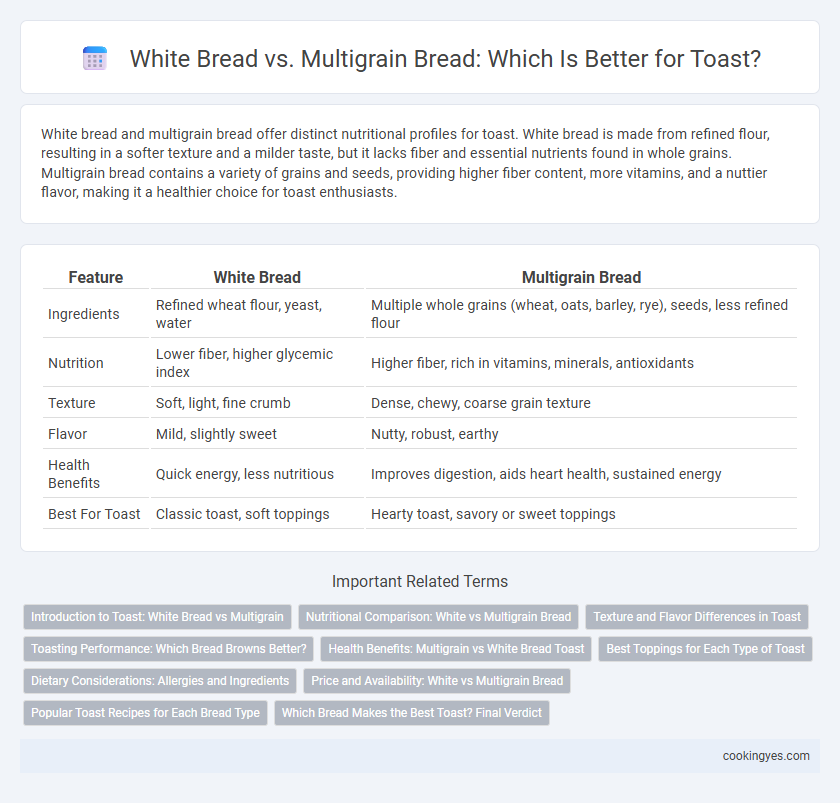White bread and multigrain bread offer distinct nutritional profiles for toast. White bread is made from refined flour, resulting in a softer texture and a milder taste, but it lacks fiber and essential nutrients found in whole grains. Multigrain bread contains a variety of grains and seeds, providing higher fiber content, more vitamins, and a nuttier flavor, making it a healthier choice for toast enthusiasts.
Table of Comparison
| Feature | White Bread | Multigrain Bread |
|---|---|---|
| Ingredients | Refined wheat flour, yeast, water | Multiple whole grains (wheat, oats, barley, rye), seeds, less refined flour |
| Nutrition | Lower fiber, higher glycemic index | Higher fiber, rich in vitamins, minerals, antioxidants |
| Texture | Soft, light, fine crumb | Dense, chewy, coarse grain texture |
| Flavor | Mild, slightly sweet | Nutty, robust, earthy |
| Health Benefits | Quick energy, less nutritious | Improves digestion, aids heart health, sustained energy |
| Best For Toast | Classic toast, soft toppings | Hearty toast, savory or sweet toppings |
Introduction to Toast: White Bread vs Multigrain
White bread and multigrain bread differ significantly in nutritional content and flavor, impacting their suitability for toast. White bread is made from refined flour, offering a soft texture and mild taste but lower fiber and micronutrients. Multigrain bread incorporates various whole grains and seeds, providing higher fiber, vitamins, and a denser, nuttier flavor that enhances the toast experience.
Nutritional Comparison: White vs Multigrain Bread
Multigrain bread offers higher fiber content, essential vitamins, and minerals compared to white bread, which is primarily made from refined flour lacking significant nutrients. White bread has a higher glycemic index, leading to faster blood sugar spikes, while multigrain bread supports better glycemic control due to its complex carbohydrates. Choosing multigrain bread for toast provides a more balanced nutritional profile that promotes sustained energy and digestive health.
Texture and Flavor Differences in Toast
White bread toast boasts a soft, airy texture with a mild, slightly sweet flavor that crisps evenly without overwhelming other toppings. Multigrain bread toast offers a denser, heartier texture combined with a nutty, complex flavor profile due to the blend of seeds and grains. These differences significantly impact the overall toast experience, making white bread ideal for a light crunch and multigrain perfect for a rich, textured bite.
Toasting Performance: Which Bread Browns Better?
White bread toasts more evenly and achieves a consistent golden-brown color due to its finer crumb structure and higher sugar content, which promotes Maillard reaction during toasting. Multigrain bread often browns unevenly because its denser texture and varied grain composition can create spots that toast at different rates. For optimal toasting performance with a balanced crunch and color, white bread generally outperforms multigrain bread in browning efficiency.
Health Benefits: Multigrain vs White Bread Toast
Multigrain bread toast offers superior health benefits compared to white bread toast due to its higher fiber content, which aids digestion and helps maintain stable blood sugar levels. Rich in essential nutrients like B vitamins, iron, magnesium, and antioxidants, multigrain bread supports heart health and boosts metabolism more effectively than refined white bread. Choosing multigrain toast can contribute to better weight management and reduced risk of chronic diseases such as diabetes and cardiovascular conditions.
Best Toppings for Each Type of Toast
White bread toast pairs perfectly with classic toppings like creamy butter, smooth fruit jams, and honey, enhancing its soft texture and mild flavor. Multigrain bread toast benefits from hearty toppings such as avocado slices, nut butter, and cottage cheese, complementing its dense, nutty profile and providing added nutritional value. Choosing toppings that align with the bread's texture and taste elevates the overall toast experience.
Dietary Considerations: Allergies and Ingredients
White bread for toast typically contains refined wheat flour and fewer allergens, making it a safer option for individuals with gluten sensitivity or wheat allergies, though it lacks fiber and essential nutrients. Multigrain bread includes a mix of grains like oats, barley, and flaxseed, offering higher fiber and nutrient content but may introduce allergens such as nuts, seeds, or soy, requiring careful label examination. Choosing between white and multigrain bread for dietary needs depends on individual allergies and nutritional goals, with multigrain often better for digestion and heart health while white bread suits simpler allergy management.
Price and Availability: White vs Multigrain Bread
White bread is generally more affordable and widely available in most grocery stores compared to multigrain bread, making it a budget-friendly option for daily toast. Multigrain bread tends to have a higher price point due to its diverse grain content and often limited production scale. Consumers might find white bread stocked consistently on shelves, while multigrain bread availability can vary by location and brand specialty.
Popular Toast Recipes for Each Bread Type
White bread's soft texture makes it ideal for classic toast recipes like avocado toast topped with cherry tomatoes and a sprinkle of feta cheese. Multigrain bread, rich in fiber and nutrients, pairs well with savory toppings such as hummus and roasted vegetables or sweet options like almond butter with banana slices. Both bread types offer versatile bases, catering to diverse flavor preferences and nutritional needs in popular toast creations.
Which Bread Makes the Best Toast? Final Verdict
White bread produces a soft, evenly browned toast with a mild flavor that complements sweet and savory toppings, making it a classic choice for many. Multigrain bread offers a denser, nuttier toast with higher fiber content and complex textures, appealing to those seeking health benefits and richer taste profiles. The best toast depends on individual preference: white bread excels in light and tender toast, while multigrain bread provides a hearty and nutrient-rich alternative.
White Bread vs Multigrain Bread for Toast Infographic

 cookingyes.com
cookingyes.com